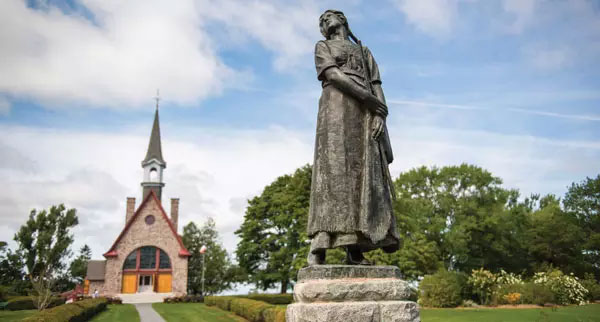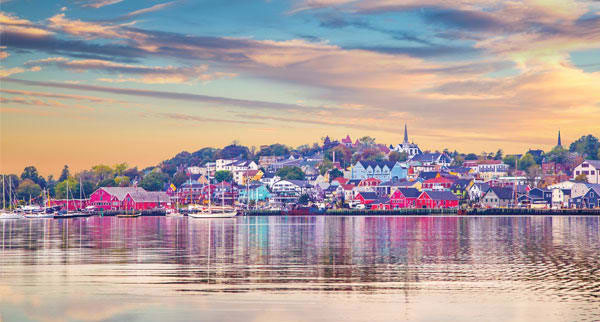Go beyond the Cabot Trail to find the stories that have shaped Nova Scotia, writes Katie McGonagle.
Click here to download and save as a PDF.
“This is the high street, don’t blink,” says our guide Paul, as we turn into the quiet, waterfront road that passes for Annapolis Royal’s main highway.
Edged with clapboard houses in pastel hues, dainty rose gardens, tiny independent inns and arty boutiques, it’s a blink-and-you’ll-miss-it sort of town.
But in Canada, known for its open spaces and towering scenery, that’s all part of the charm. Even in the maritime province of Nova Scotia – which usually makes it into brochures only for the high tides in the Bay of Fundy, the scenery of the Cabot Trail or the iconic lighthouse at Peggy’s Cove – the chance to uncover a cultural, historical side makes a refreshing change.
Annapolis Royal
You’d hardly know this was once the thriving capital of Nova Scotia, home to one of the oldest European settlements in North America, starting off as an outpost for French immigrants in 1605, and passing – along with the rest of the country – back and forth between French and British hands in the centuries that followed.
Needless to say, it was under British control when it was renamed Annapolis Royal, for the monarch of the day, Queen Anne.
Yet a late-night tour of the graveyard alongside Fort Anne Historic Site, right on the waterfront, shows a different side to this once-busy trading centre. Candlelit lanterns in hand, we follow guide Alan Melanson (pictured) – a 10th‑generation Acadian, with a little Mi’kmaw ancestry in the mix – from the fort to the crumbling, early 18th-century headstones of the neighbouring graveyard.
“This was once the thriving capital of Nova Scotia, home to one of the oldest European settlements in North America.”
He regales us with stories of abandoned army wives, God-fearing husbands with an eye on the heavens, and tales of the elaborate dinners held here by French explorer Samuel de Champlain and his Order of Good Cheer – so lively, we can almost taste the moose-nose soup, a dish sure to stick in the mind, and possibly the gullet, too.
But it’s the memorial to the fascinating local figure Rose Fortune that really stands out, commemorating a freed Pennsylvania slave who fled to Nova Scotia after the American Revolution, and ended up becoming Canada’s first police woman. In the 1980s, one of her descendants, Daurene Lewis, was elected the country’s first black mayor.
In fact, Nova Scotia’s entire history is one long tale of settlers and the dispossessed, from the native Mi’kmaq, whose way of life was changed for ever by the arrival of the Europeans, to the Acadian farmers who were, themselves, thrown off land they had cultivated for years amid the struggle between European powers.
Small it might be, but this town – and by extension, the entire province – has plenty of interesting stories hiding just below the surface.

Grand Pre Historic Site
Speaking of storytelling, Grand Pré National Historic Site is the place to go to hear the shocking plight of the Acadian settlers, who established themselves as farmers in the late 17th and early 18th centuries, becoming the first generation to be born and raised here rather than moving over from France.
They took floodplains filled with seawater and, through hard work and a little technological knowhow, transformed them into farmland. But even all the way across the Atlantic, these simple farmers were drawn into the vicissitudes of the Seven Years War with France, when the British decided to assert their control over modern-day Canada by expelling the Acadians from the land they had lived on for years.
“Hear the shocking plight of the Acadian settlers, who established themselves as farmers in the late 17th and early 18th centuries.”
Deported and scattered across the Americas – the word ‘Cajun’ in Louisiana comes from a distortion of the name ‘Acadian’, whose descendants can still be found there today – it was only in 1763 that Acadians were permitted to return. Many stayed put, or returned to find New England planters had taken up residence on their hard-won land, leaving them to start all over again.
The story is told in the epic poem Evangeline, by Henry Wadsworth Longfellow, and statues of the poet and his most famous character can be found at Grand Pré, along with excellent interpretative guides from Parks Canada, who turn these long-ago events into dramatic, living history.

Annapolis Valley
Fast-forward to today, and the Annapolis Valley is a very different place – more focused on wine than on war. It’s a relatively recent innovation here, with the first winery opening its doors in 1979, but since then, 23 small, mostly family-run, vineyards have sprung up around the province.
The signature grape, L’Acadie blanc, was a tad sharp for my tastes, though it pairs well with the Digby scallops and fresh lobster that grace many a menu here. But if that’s not to your clients’ liking, the province’s only appellation, a blend known as Tidal Bay, is more of a crowd-pleaser.
“L’Acadie blanc was a tad sharp for my tastes, though it pairs well with the Digby scallops and fresh lobster that grace many a menu here.”
Recommend a wine tasting, or even more than one. At Domaine de Grand Pré, the delightful restaurant is matched by an affordable wine-tasting experience, costing just £5 for a regular tasting and £9 for premium wines, open to the public at 11am and 4pm daily during high season.
But if visitors want a real feel for the region’s unique grapes – and someone else to do the driving – book the Magic Winery Bus, a nifty London double-decker that operates on a loop, so wine aficionados can hop on and off on a tour around the wineries of Wolfville (£30, including a complimentary wine on arrival at each winery).

Lunenburg
If wine is a relatively modern invention here, fishing is quite the opposite. This maritime province has always had a close connection with the sea, and never more so than in the picture-postcard south coast town of Lunenburg.
The Unesco-listed old town, established in 1753, is just about as charming a neighbourhood as you’re ever likely to find, mixing British colonial style with the hallmark architecture of its predominantly German Lutheran population.
These days, though, it’s known for the colourful rows of houses lining the main street leading to the waterfront, where the famous schooner the Bluenose II can be spotted in the harbour.
“Like everything in Nova Scotia, it pays to dig a little deeper into the stories that lie behind the landscapes.”
Book a walking tour to uncover the stories that lie inside its pretty houses (from £15 with Lunenburg Walking Tours between June and October). Enthusiastic guide Ashlee takes visitors from the peeling facade of the Lunenburg Academy – home to the town’s only primary school, until surprisingly recently – via the Anglican church that burnt down in a dramatic fire in 2001 but was rebuilt in an exact replica of the original, finishing at the Fisheries Museum of the Atlantic.
If the allure of a pleasant, sunny lunch in one of the many delightful restaurants that line the waterfront isn’t too strong, the museum is worth a visit. It explores the community’s fraught relationship with the sea, which is its main source of income, but also a source of danger in a time when a storm could send a ship down with all hands.
The Theresa E Connor, the last of the salt-bank schooners to operate out of Lunenburg, is moored right outside the museum, and visitors can go onboard for a glimpse of the cramped conditions that existed on the town’s fishing boats.
Learning about life at sea puts some of the province’s stunning coastal spots, such as beautiful Mahone Bay or the much-photographed lighthouse at Peggy’s Cove, into perspective. But like everything in Nova Scotia, it pays to dig a little deeper into the stories that lie behind the landscapes – a trip will be all the richer for it.
Sample product
First Class Holidays offers an Atlantic Charm self-drive holiday that takes in Halifax, Lunenburg, Annapolis Royal, Wolfville, Cape Breton Island and the Cabot Trail. Prices start at £2,279 per person, including flights, car hire and accommodation, based on a departure on June 11, 2019.
fcholidays.com
Tauck operates an eight-day Nova Scotia & Prince Edward Island tour that visits Halifax, Peggy’s Cove, Lunenburg, Charlottetown and Green Gables House on PEI, returning to Nova Scotia for whale-watching on the Bay of Fundy and a stop at Grand-Pré National Historic Site. Prices start at £2,190 in 2019.
tauck.co.uk
Read more
Whale watching in Churchill, Manitoba in summer
Alternative bucket list experiences in Canada
Learn about Canada’s indigenous history in Ottawa




